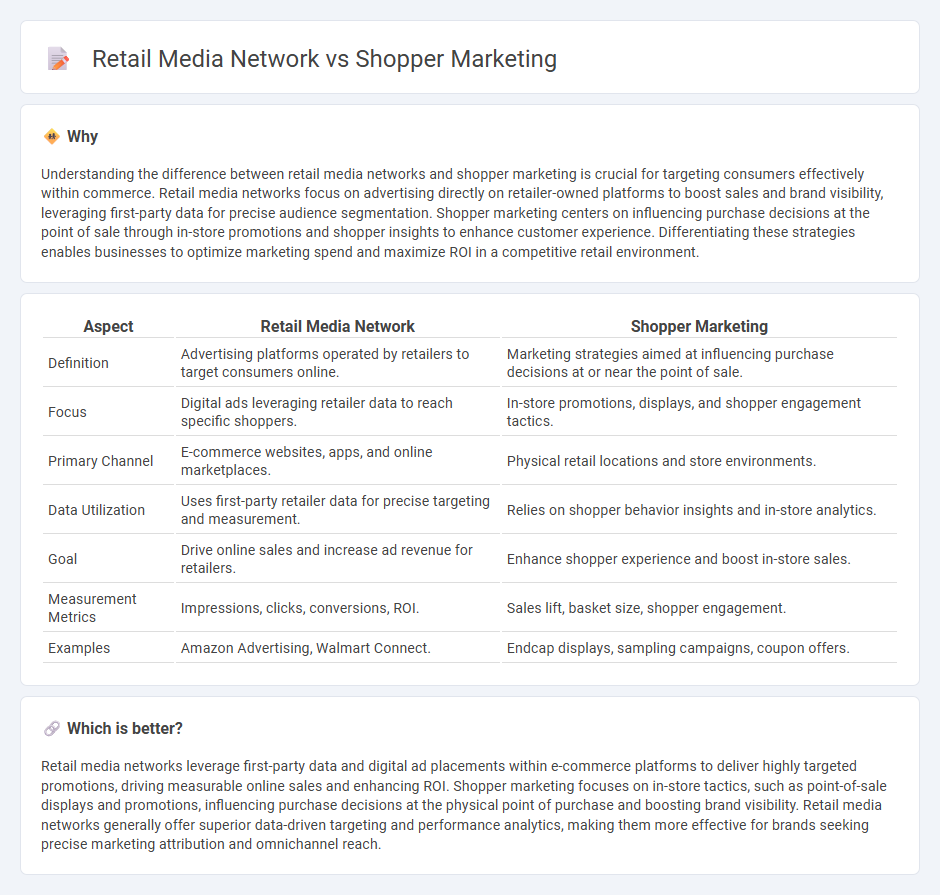
Retail media networks leverage retail platforms to deliver targeted advertising based on consumer purchase data, driving measurable returns for brands. Shopper marketing focuses on influencing consumer behavior at the point of sale through in-store promotions and personalized experiences. Explore the differences to enhance your commerce strategy effectively.
Why it is important
Understanding the difference between retail media networks and shopper marketing is crucial for targeting consumers effectively within commerce. Retail media networks focus on advertising directly on retailer-owned platforms to boost sales and brand visibility, leveraging first-party data for precise audience segmentation. Shopper marketing centers on influencing purchase decisions at the point of sale through in-store promotions and shopper insights to enhance customer experience. Differentiating these strategies enables businesses to optimize marketing spend and maximize ROI in a competitive retail environment.
Comparison Table
| Aspect | Retail Media Network | Shopper Marketing |
|---|---|---|
| Definition | Advertising platforms operated by retailers to target consumers online. | Marketing strategies aimed at influencing purchase decisions at or near the point of sale. |
| Focus | Digital ads leveraging retailer data to reach specific shoppers. | In-store promotions, displays, and shopper engagement tactics. |
| Primary Channel | E-commerce websites, apps, and online marketplaces. | Physical retail locations and store environments. |
| Data Utilization | Uses first-party retailer data for precise targeting and measurement. | Relies on shopper behavior insights and in-store analytics. |
| Goal | Drive online sales and increase ad revenue for retailers. | Enhance shopper experience and boost in-store sales. |
| Measurement Metrics | Impressions, clicks, conversions, ROI. | Sales lift, basket size, shopper engagement. |
| Examples | Amazon Advertising, Walmart Connect. | Endcap displays, sampling campaigns, coupon offers. |
Which is better?
Retail media networks leverage first-party data and digital ad placements within e-commerce platforms to deliver highly targeted promotions, driving measurable online sales and enhancing ROI. Shopper marketing focuses on in-store tactics, such as point-of-sale displays and promotions, influencing purchase decisions at the physical point of purchase and boosting brand visibility. Retail media networks generally offer superior data-driven targeting and performance analytics, making them more effective for brands seeking precise marketing attribution and omnichannel reach.
Connection
Retail media networks leverage shopper marketing insights to deliver targeted advertisements within shopping environments, enhancing consumer engagement and purchase intent. By utilizing first-party data from shopper behavior and preferences, these networks optimize ad placements to drive conversion rates effectively. The integration of retail media and shopper marketing creates a feedback loop that refines marketing strategies based on real-time shopping activity.
Key Terms
Shopper Marketing:
Shopper marketing targets consumers directly at the point of purchase, using personalized content, in-store promotions, and shopper insights to influence buying decisions and enhance the customer experience. It leverages data analytics and behavioral patterns to create tailored campaigns that drive conversion and brand loyalty. Explore how shopper marketing strategies can optimize consumer engagement and boost sales effectively.
Path to Purchase
Shopper marketing targets consumers by influencing their purchase decisions through in-store promotions, personalized experiences, and shopper insights, optimizing the Path to Purchase at the point of sale. Retail Media Networks leverage data from retailers to deliver targeted advertising across digital platforms, enhancing consumer engagement throughout the online and offline buying journey. Explore how integrating both strategies can maximize impact across every stage of the Path to Purchase.
In-store Activation
Shopper marketing emphasizes personalized in-store activations that engage consumers at the point of purchase, driving immediate sales and brand loyalty through sensory experiences and targeted promotions. Retail media networks leverage digital platforms within the store environment to deliver data-driven advertising and measure shopper interactions, enhancing precision in campaign performance. Discover how integrating these strategies can maximize in-store impact and elevate customer engagement.
Source and External Links
What Is Shopper Marketing? Definition and Tactics (2024) - Shopper marketing is a strategy leveraging behavioral insights to influence consumer purchasing decisions at key journey points, aiming to transform browsing into buying by meeting customers at critical moments with tailored tactics like in-store displays or personalized online ads.
Shopper Marketing Strategy: A Guide for CPG Brands - Shopper marketing is a data-driven approach focused on driving demand and conversion by addressing why consumers should care and buy, and why retailers should support, creating a triple win for brand equity, shopper experience, and retail sales.
Shopper Marketing: Key Principles and Real-World Examples - Shopper marketing drives sales by engaging consumers at point-of-sale with compelling experiences and fosters strong brand-retailer collaboration vital for success in the competitive retail landscape.
 dowidth.com
dowidth.com